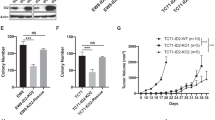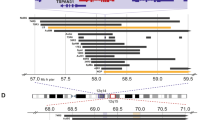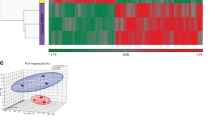Abstract
In an earlier study designed to investigate molecular mechanisms of carcinogenesis in synovial sarcomas (SSs), we applied a cDNA microarray to detect human genes with significantly increased expression in SS cells. Among the genes selected in this way, we identified a novel transcript, subsequently designated PDZK4 (PDZ domain-containing 4), that was specifically upregulated in all of the 13 SS cases we examined. On Northern blots of normal human tissues, the PDZK4 transcript was expressed only in fetal brain. Immmunocytochemical staining of transfected COS7 cells showed that the PDZK4 gene product localized mainly under the plasma membrane. Treatment of human SS cells with small interfering RNA (siRNA) inhibited the expression of PDZK4 and resulted in the suppression of tumor-cell growth. Induction of exogenous PDZK4 expression promoted growth of T98G and COS7 cells in which no endogenous expression of PDZK4 was observed. Taken together, these findings strongly suggest that inappropriate expression of PDZK4 might play an important role in the proliferation of SS cells and that the gene might be a suitable molecular target for designing of novel drugs to treat SS patients.
This is a preview of subscription content, access via your institution
Access options
Subscribe to this journal
Receive 50 print issues and online access
$259.00 per year
only $5.18 per issue
Buy this article
- Purchase on Springer Link
- Instant access to full article PDF
Prices may be subject to local taxes which are calculated during checkout




Similar content being viewed by others
References
Antman K, Crowley J, Balcerzak SP, Rivkin SE, Weiss GR, Elias A, Natale RB, Cooper RM, Barlogie B and Trump DL . (1993). J. Clin. Oncol., 11, 1276–1285.
Bezprozvanny I and Maximov A . (2001). Proc. Natl. Acad. Sci. USA, 98, 787–789.
Cao TT, Deacon HW, Reczek D, Bretscher A and von Zastrow M . (1999). Nature, 401, 286–290.
Clark J, Rocques PJ, Crew AJ, Gill S, Shipley J, Chan AM, Gusterson BA and Cooper CS . (1994). Nat Genet, 7, 502–508.
Crist WM, Anderson JR, Meza JL, Fryer C, Raney RB, Ruymann FB, Breneman J, Qualman SJ, Wiener E, Wharam M, Lobe T, Webber B, Maurer HM and Donaldson SS . (2001). J. Clin. Oncol., 19, 3091–3102.
dos Santos NR, de Bruijn DR and van Kessel AG . (2001). Genes Chromosomes Cancer, 30, 1–14.
Edmonson JH, Petersen IA, Shives TC, Mahoney MR, Rock MG, Haddock MG, Sim FH, Maples WJ, O'Connor MI, Gunderson LL, Foo ML, Pritchard DJ, Buckner JC and Stafford SL . (2002). Cancer, 94, 786–792.
Fanning AS and Anderson JM . (1999). J. Clin. Invest., 103, 767–772.
Ferguson WS and Goorin AM . (2001). Cancer Invest., 19, 292–315.
Frustaci S, Gherlinzoni F, De Paoli A, Bonetti M, Azzarelli A, Comandone A, Olmi P, Buonadonna A, Pignatti G, Barbieri E, Apice G, Zmerly H, Serraino D and Picci P . (2001). J. Clin. Oncol., 19, 1238–1247.
Hirao K, Hata Y, Yao I, Deguchi M, Kawabe H, Mizoguchi A and Takai Y . (2000). J. Biol. Chem., 275, 2966–2972.
Hung AY and Sheng M . (2002). J. Biol. Chem, 277, 5699–5702.
Mizuno K, Suzuki A, Hirose T, Kitamura K, Kutsuzawa Y, Futaki M, Amano Y and Ohno S . (2003). J. Biol. Chem., 278, 31240–31250.
Nagai M, Tanaka S, Tsuda M, Endo S, Kato H, Sonobe H, Minami A, Hiraga H, Nishihara H, Sawa H and Nagashima K . (2001). Proc. Natl. Acad. Sci. USA, 98, 3843–3848.
Nagayama S, Katagiri T, Tsunoda T, Hosaka T, Nakashima Y, Araki N, Kusuzaki K, Nakayama T, Tsuboyama T, Nakamura T, Imamura M, Nakamura Y and Toguchida J . (2002). Cancer Res., 62, 5859–5866.
Ohno S . (2001). Curr. Opin. Cell Biol., 13, 641–648.
Pawson T and Scott JD . (1997). Science, 278, 2075–2080.
Patel SR, Vadhan-Raj S, Burgess MA, Plager C, Papadopolous N, Jenkins J and Benjamin RS . (1998). Am. J. Clin. Oncol., 21, 317–321.
Sarcoma Meta-analysis Collaboration (1997). Lancet, 350, 1647–1654.
Shoji H, Tsuchida K, Kishi H, Yamakawa N, Matsuzaki T, Liu Z, Nakamura T and Sugino H . (2000). J. Biol. Chem., 275, 5485–5492.
Tsunoda S, Sierralta J, Sun Y, Bodner R, Suzuki E, Becker A, Socolich M and Zuker CS . (1997). Nature, 388, 243–249.
van de Rijn M, Barr FG, Collins MH, Xiong QB and Fisher C . (1999). Am. J. Clin. Pathol., 112, 43–49.
Weiss SW and Goldblum JR . (2001). Enzinger and Weiss's Soft Tissue Tumors, 4th edn. Elsevier Science Health, Science dir: Mosby, St Louis.
Wunder JS, Paulian G, Huvos AG, Heller G, Meyers PA and Healey JH . (1998). J. Bone Jt. Surg. Am., 80, 1020–1033.
Xu J, Paquet M, Lau AG, Wood JD, Ross CA and Hall RA . (2001). J. Biol. Chem., 276, 41310–41317.
Acknowledgements
We gratefully thank Ms Kie Naito and Ms Yumi Kondo for technical assistance and Dr Chikako Fukukawa for Western blotting analysis and Drs Hiroshi Sonobe and Akira Kawai for kindly providing SS cell lines. This work was supported in part by Research for the Future Program Grant #00L01402 from the Japan Society for the Promotion of Science.
Author information
Authors and Affiliations
Corresponding author
Rights and permissions
About this article
Cite this article
Nagayama, S., Iiizumi, M., Katagiri, T. et al. Identification of PDZK4, a novel human gene with PDZ domains, that is upregulated in synovial sarcomas. Oncogene 23, 5551–5557 (2004). https://doi.org/10.1038/sj.onc.1207710
Received:
Revised:
Accepted:
Published:
Issue Date:
DOI: https://doi.org/10.1038/sj.onc.1207710
Keywords
This article is cited by
-
Molecular evolution of the LNX gene family
BMC Evolutionary Biology (2011)
-
Involvement of elevated expression of multiple cell-cycle regulator, DTL/RAMP (denticleless/RA-regulated nuclear matrix associated protein), in the growth of breast cancer cells
Oncogene (2008)
-
Involvement of upregulation of DEPDC1 (DEP domain containing 1) in bladder carcinogenesis
Oncogene (2007)
-
Diagnosis and Management of Synovial Sarcoma
Current Treatment Options in Oncology (2005)



